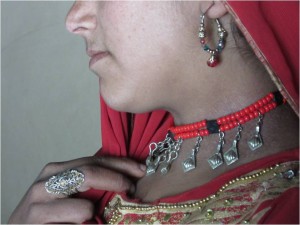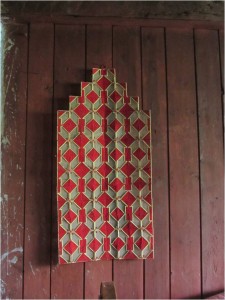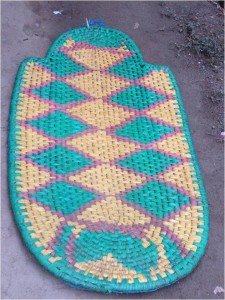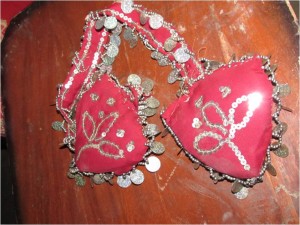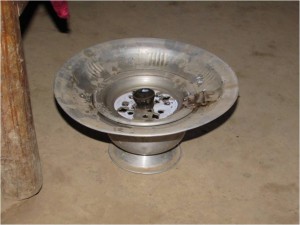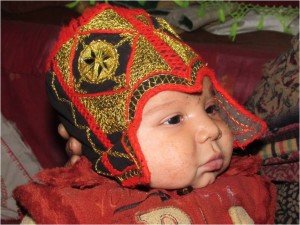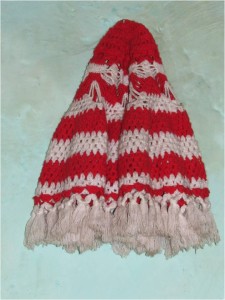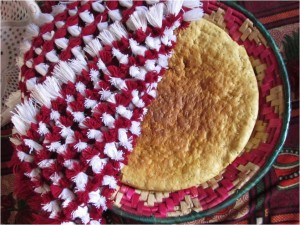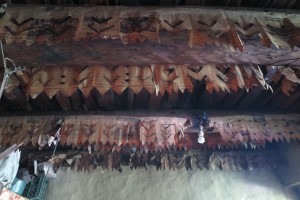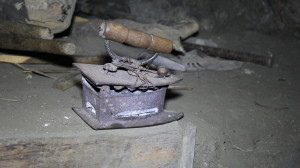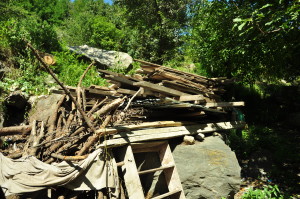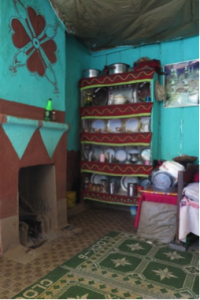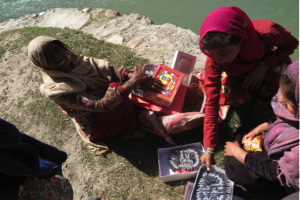CRAFT
1. Triangular Motif Embroidery
Description: Embroidery is done on bed sheets, handkerchief and shelf covers by women. The triangular pattern of embroidery resembles a tree shape and is locally known as “Nawaz Sharif tanka”
Personal Note: It is the second most popular stitch after the Sindhi embroidery.
2. Handmade Dolls
Description: Young girls make dolls by stitching clothes and stuffing them with cotton. Hair of the dolls are made with wool thread.
Personal Note: At times, they also modify the ready-made dolls from the market by adding embellishments etc.
3. Ping Pong Balls For Making Pom-pom
Description: Ping pong balls are used as a decorative element that hangs as tassel at the end of a circular pillow. To make pom-poms they use ping Pong balls and wrap cloth around them or knit a crochet which is further decorated by sequence.
4. Guch
Description: Women make decorative paper lanterns and hang it to the ceilings.
5. Knitted Plate Covers
Description: Local women knit plate and tray covers by a technique called “Qaroshia”. The technique is popularly known as crochet. They decorate these covers with beads, pearls and sequences.
6. Rumaal
Description: During a wedding in a family, the women of the house decorate a handkerchief for the groom. Usually a cotton cloth is used for the surface which is elaborately embroidered.
Personal note: Usually they make a heart with an arrow on it and write the name initials of the groom and his brothers.
Description: Colored beads are strung together to make ornaments such as necklace, bracelet and earrings. Village women create these pieces that are worn on a daily basis. These jewelry pieces are found nearly in every village as Khannian, Ranjhri and Bela. Colored Beads and metal coins are used to adorn the jewelry.
Personal Note: With the rising prices in silver and gold jewelry. Locals have started wearing these affordable crafted pieces.
Description: Mats are designed by the local women to offer prayers, which are used domestically. Women create embroidery pattern inspired from Phulkari motifs. Long stitches are applied to fill in the design. Wool thread is usually used for embroidery. The color palate is vibrant. Red, pink and lime are some of the popular colors. They are found in houses of Ranjhri, Bela,Khannian villages in Naran Valley.
Personal Note: The geometric design of each prayer mat is unique, as it does not follow an established pattern, therefore is distinct and individual. The crafter follows her instincts and aesthetics in the design process. Material choices for the base fabric varies from a plastic sack to a cotton fabric. Plastic is ideal as it’s cheap and durable, because of its loose warp and weft, the wool thread is easier to pass through.
Description:These prayer mats are mostly seen in the households of Baatakundi. Also crafted by the women. They are used domestically. Plastic robes are interwoven together to make a pattern. The motifs are usually bold and geometric.
Personal note: Weaving techniques similar to Basket weave can be seen in these mats. It seems like the technique and pattern used in making of chaff[ted] plates also know as “Chengair or Chabba”.So it can be assumed that the weaving is the bolder interpretation of the same technique
Description: Wall hangings are made by stuffing cotton in the shape of a heart or flower. These hangings are usually part of a woman’s dowry and is used to decorate walls and doors of the bride’s room. Material for the hanging is preferably a red silk fabric, embellished with sequins, beads and coins. The tradition of making these is observed in Ranjhri, Bela,Khannian.Baatakundi.
Personal note: These decorations are part of a girl’s dowry. Sometimes it’s adorned by sewing initials of the newly wed or with words such as “Love”
“Welcome”, but at times only a heart or flower motif.
Description: This utensil is used for washing hands and is mostly offered to special guests. It has two components the trough and the jug “Lota”. Used water collects at the bottom of the utensil while Lota is used to pour water over the hands. It is made with steel or silver material.
Personal note: Similar practice (of washing hands) has been observed in the Neelum valley’s remote village ArangKel. Upon questioning the local’s linked their lineage with the Mughals of the Subcontinent, claiming them to be there offshoot descendants.
Description:These Chabba’s are used in every household for serving bread. These are made by the women in their summerhouses in Mansera (KPK). After talking out the grain wheat stalks are dyed and woven together to create a circular plate form. The stalks are dyed in two or three colors and are woven along with the original beige color of the stalk. Patterns vary in size and shapes, depending upon the preference.
Personal note: The migratory life style of the people gives this region an interesting edge. Not only they have homes in both the cities, they also learn new crafts and techniques that are incorporated into their lifestyle. Plates, baskets, dishes and hanging pots are made from the same material and chengair making technique.
Description: The purpose of the cap is to give a newborn baby’s head a smooth round shape. These caps are decorated with embroidery patterns with wool thread and gold tilla. Moti tanka, Kacchi khadhai are common stitches. Usually White and Black base is used for the caps. Red wool is also a popular choice for the embroidery.
Personal note: Mothers and grandmothers from all the villages of the Valley stitch and embroider these caps. The mothers also hide a needle in the last stitch as a practice to prevent the child from evil eye.
14. Sindhi Embroidery
Description:Found in houses of Khannian ,Beela , Ranghri and also Battakundi, Sindhi embroidery is popular all across the valley. Embroidered with a cotton and wool thread, Sindhi patterns are used to make multiple products such as bed sheets, pillow covers, clothes and shelf covers.
Personal note: This embroidery has traveled all the way from Sindh to Naran Valley. This shows their interactions with other communities and the people are exposed to various craft practices. This has been possible due to their migratory lifestyle. As they travel to Balakot and Mansehra in winters. Some family members also live in other cities such as Karachi and Rawalpindi.
Description: Crochet is practiced by nearly all the women of the valley. Made with four and two ply wool, these colorful plate covers have been seen in every household. Many other things such as coasters, table mats or Quran covers are also made with the same technique. Some women also knit sweaters for their family members.
Personal note: Colorful crochet is another example of interconnection between the plains and mountains.
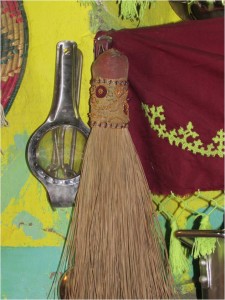 16. Chir-jharoo (Green Pine Broom)
16. Chir-jharoo (Green Pine Broom)
Description: These dusters or brooms are made from dried branches of Cheir tree used by every house in Naran valley. It is hung over the clay fireplace for easy access to clean the kitchen area. Women often decorate one side with sequins, beads and little motifs of embroidery.
Personal note: Similar dusters are also used to clean the floors.
17. Phulkari Embroidery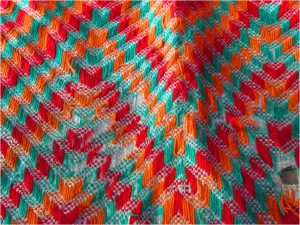
Description: Phulkari technique has been adopted to decorate various household products especially prayer mats. With colorful wool thread, geometric patterns are created with a long stitch. Repetition of the same stitch creates a solid geometric from.
Personal note: This embroidery has traveled all the way from Punjab to Naran Valley. It’s evident how the community adopts these patterns. Phulkari patterns look vibrant and eye catching.
HERBS
Description: Flour, eggs,cumin,baking soda, milk and ghee are the basic ingredients of this cake. In Naran Valley there are no gas or electric ovens, therefore it’s cooked on firewood in a mud plastered silver pot. A flat pan is used at the base and a wok on top with coals, to provide heat from the top and bottom.
Personal note: The cake is considered special and is made as a treat. It is also a hybrid recipe, inspired from the urban methods of baking. But personalization and adaptation of the baking process makes it unique.
19. Face Pack for Brides
Description: This face pack is applied by maidens a week or month before their marriage. Mustard seeds are soaked in water, overnight and ground into a paste, yogurt is added into it. The paste is used for a clear skin and glow.
20. Ajwain
Description: Ajwain is used to make tea and it is very helpful in curing stomachache.It prevents vomiting and indigestion, as well.
21. Battpawa
Description: Locals use “Battpawa” for stomach disorders and it is extracted from the roots of a plant.
22. Chorra
Description: Chorra is extracted from the roots of a plant and it is used for digestion and stomach gas.
23. Chittyal
Description: Chittyal is leaf of a specific tree and it is used to cure physical injuries.
24. Deodar Tree (gum)
Description: Gum from Deodar is widely used for removing ticks, lice and flea in animals and humans.
25. Dangsonchal (root)
Description: Dangsonchal is a root that helps in reduction of stomach inflammation and mucus problem and is alkaline in nature.
26. Jaoow (Heather-bush)
Description: Jaoow is available in Black/white form. Locals consume it for removing stomach worms. It is also helpful in chest burning and asthma. In some cases, it is said that it cures cancer as well.
27. Korijarr
Description: Kori jar is a root and it is helpful in stomach ache and gas. Locals use it for curing cold and fever.
28. Jinadam
Description: Jinadam is a leaf and it is used for any kind of external pain.
29. Teenpatra
Description: Teenpatra is used in root and leaf form.To relief stomach related problems.
30. Ratan-Jogh
Description: Ratan-Jogh is extracted from roots and is used for animals. This herb helps in purifying and increases milk production.
31. Organic onions
Description: Organic onions are used for headaches. While trekking or hiking, the usage helps to balance the oxygen level of the body.
32. Mumiakh
Description: Mumiakh is a root used to cure back and joint aches.
33. Nim
Description: Nim is a gray plant and it is found in the lower region of Kaghan valley. This herb acts as antiseptic and also used as a menthol agent.
34. Kuth
Description: Kuth is a herb which acts as a pain killer.
35. Patrees
Description: Patrees is a bitter herb. In the raw form it is used for illness (cold/fever). Its boiled form is used to cure pneumonia.
36. Walnut paste
Description: Walnuts are used in the raw fruit form and its paste fanciers burns and rashes. Walnut paste is also used to whiten and clean teeth.
37. Use of Sumbal
Description: Sumbal is a plant and its roots are extracted and ground to cure wounds. It can be used on both humans and animals.
38. Dhoop
Description: Smoke of Nehra and Chilai (Herbs) are used as protection from evil eye. This practice is known as Dhoop and is considered to be a preventive force that protects women of the community from possession /influence of Jinns.
39. Kohri Daru (Herbal Medicine)
Description: A mixture of selective herbs found in the nearby forest, are collected by the elders of the community in different seasons throughout the year and ground into a powder. Kohri Daru is used to heal any minor disease/ache by all members of the community at Damdama.
Personal Note: Kohri Daru is considered to be good for your health. Hence this blended mixture of herbs is taken by people of Damdama even if they are well to avoid sickness.
40. Making Bagora (Cheese)
Description: women of the community make cheese called Bagora in Hindko. Cheese is regularly made and consumed by them.
Personal note: Unlike Khanian, the community at Damdama has collectively rejected buying the easily available packaged food products from the market. Using milk from their own cattle, the women make yougurt, butter and cheese themselves.
HOUSE HOLD
Description: Black Bear destroys the maize fields in Khannian, which is a great concern for the local villagers. Fires are lit at night in the fields to scare the bear away. They also make scarecrows.
Personal Note: Khanian and neighboring villages Ranjhri and Bela have dense forest areas where bear is inhabitant. WWF has recently passed a policy to protect the Brown Bear. Heavy penalties are issued if bear is harmed or shot, hence it fearlessly consumes the crops of local people.
42. Sleeping in trees
Description: Villagers have made sleeping arrangements on big tree trunks, where men sleep at night. This way they can keep an eye on their crops and frighten the bear away with torch or noise.
Personal Note: Mothers do not allow their children to stray outside the houses after sunset, because of the bear. Chicken and goats are locked in the barn.
43. Purj ka Taweez (Amulet for Safety)
Description: Villagers make amulet out of “purj, Purj is a tree which is commonly found in forest of Khanian.The outer layer or bark is extracted from the tree and holy verses from the Quran are written on it. People wear it around their necks or tie these around the arm to avoid evil eye and cure sickness.
44. Communal Harvest
Description: Communities help each other in the villages during the harvesting season. Crops are gifted among the community rather than being sold.
Description: Locals decorate the walls, inner roof and battens of their houses with molding and cut out paper or cloth. They decorate the fireplace with a mosaic of glass and painted patterns. Doors are also painted on the outside.
Personal Note: In Battakndi, they hang paper cuttings and lanterns from the battens during any festival. But they don’t dispose them off later on.
46. Dyaar ka tail (Deodar Tree Oil)
Description: This oil is extracted from the wood of Deodar tree. The oil is used on animal furs to prevent them of lice and ticks. Local people use it for curing wounds.
Personal Note: The most famous and oldest Deodar tree in the forest is around 900 years old. It has a diameter of 12 feet and 52 feet height.
47. Laip Karna – Mud Plaster
Description: Women of the house prepare mud mixture by mixing clay and water. The mixture is used to plaster the fireplace and floors to keep it clean and maintained. This is done every morning after breakfast.
48. Keeping, Hen and Eggs
Description: Villagers keep hens at home for the consumption of eggs. If they want to eat chicken, they buy it from the local market.
49. Dogs as Guards
Description: Locals keep dogs in their houses as guards. The noise of barking keeps away the beasts, such as the bear and lions from entering the village premises. They also keep dog in front of their herds, while grazing in pastures.
Personal Note: Separate doghouses are built, beside the barns. In the evening the dogs are taken to the entering pathways of the village where they are leashed to a rock or a nearby tree trunk.
50. Grazing Pastures
Description: Elder men take their livestock on higher mountain areas for grazing.
Personal Note: Children of the village do not take an interest in helping their fathers in caring for the animals. Rather give more importance to school and education.
51. Veterinary Doctor
Description: If any animal falls sick, the villagers call the vet in Khaghan bazaar. The doctor is available at daytime and can be called on duty. He pays a visit to the village if anyone calls him in an emergency.
52. Selling of Sick Animals
Description: Whenever a goat or a cow is sick or about to die, the locals sell it in the market at a low price. They think that if the animal dies, it would result in the loss of revenue generated.
53. Eid Preparation
Description: As a communal activity, villager’s paint their home before Eid. The house is made neat and clean.
Personal Note: Not just a cultural it is also a religious practice as most of the population in the Valley is Muslim.
54. Sun Dried Fodder
Description: Grass is dried in the sun for cows and goats and stored, for consumption in winter season. In Dumduma, fodder is dried on rooftop.
Personal note: The sun-dried grass is saved under the shelter made of sacks.
55. Returning Ashes to the Earth
Description: Locals burn wood as a source of fire and bury the ashes in the fields afterwards, as a ritual. It is a firm belief that whatever is taken from the earth, is to be returned afterwards.
56. Prohibition on Movement
Description: Maidens are advised not go outside or near the river after sunset. It is believed that Jinns or supernatural elements can attack them if they do so.
Personal Note: Many women of the village claimed to have been possessed by supernatural entities in Khannian. These stories are more popular in the villages situated along the river.
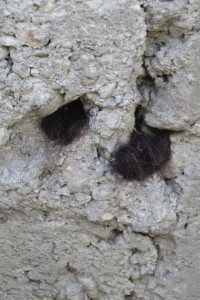 57. Collection of Hair in the Walls
57. Collection of Hair in the Walls
Description: Hair that fall while combing are rolled into a ball and kept in wall niches. When enough hair is collected, they bury it in the ground or throw them in the flowing water. This is done in order to avoid black magic.
58. Hanging Goat Horns
Description: Villagers hang goat’s horn outside their door to avoid evil eye and bad omen.
59. Manjann
Description: Branches of a Walnut tree are ground to make powder locally known as “majnann”. It is used to clean and whiten teeth.
60. Treating Burnt Skin
Description: To treat burnt skin, locals make a paste from walnuts and apply it on burnt skin.
61. Organic Lip Color
Description: The leaf of a Walnut tree is also used by the local women for personal adornment. The Women rub the leaf on their lips for ruddy color.
62. Kajla
Description: Women burn “tawa” and use the black soot as liner for their eyes. They use this to enhance the beauty of their eyes.
Personal Note: Tawa is a flat or a semi circular iron utensil that is used to make flat breads, commonly known as Roti.
63. Visiting Potter
Description: A past tradition when potter’s used to come to the village and make clay pots for domestic use under the supervision of local women.
Personal Note: In more remote villages such as Battakundi, this was still a practice until the Earthquake of 2005 after which the Potters have stopped visiting the mountains.
64. Charkha
Description: Charkha is made of wood and rope. Women used to keep a Charkha at their homes by which they synthesized the thread.
65. Mud Stoves
Description: Women make the stove out of mud mixture and is a temporary feature and needs re-making. Usually it is lined with stones at the base and plastered with mud. In Khannian it lasts for about 2 months and in Batakundi it usually lasts for 6-8 months.
66. Butter Storage
Description: Local women make butter at their homes and preserve it underground for consumption.
67. Avoid Throwing Stone in the River
Description: People here firmly believe that if someone throws a stone in the river, the Jinn will catch him hence they avoid throwing stones especially after sunset.
68. Synthesizing Honey “Dhandora”
Description: For synthesis of honey, the locals make a box of clay or wood where the bees come into it to produce honey. Some sweet such as Gur or brown sugar is kept inside to attract them. They lock it once the bees are done with making honey.
Personal note: There was only one elderly woman in the village that can break the beehive to extract honey as bees do not harm her. “Dhandora” is a local name for beehive.
69. Dowry Display
Description: It is a custom to display their dowry on the shelves that are covered with embroidered cloth.
70. Kutmutra
Description: Kutmutra is a type of local mushroom and is not edible. Local villagers believe that when a dog urinates on the ground, these mushrooms grow hence nobody uses them.
Description: Due to lack of the natural gas supply, people in the valley iron their clothes with coal iron.
72. Azaarban
Description: This is a string made from crochet, which is given to the groom by the bride’s family. Women and girls knit Azaabar of cotton or woolen threads.
73. Peehri
Description: Women use a low height stool for seating while working in the kitchen or otherwise. In local language, it is called “peehri”.
74. Bride’s Dowry
Description: In Battakundi, a Bride is supposed to bring bed sets for all the family members, including sister in law’s and brother in law’s as a part of her dowry.
Personal Note: Women from an early age start practicing embroidery in their leisure hour. This way they keep making their dowry.
75. Phandi
Description: Local women fill the cushion with the husk of rice grain, that is used for sitting while cooking and cleaning.
76. Sajj (Elaborate Wedding Banners)
Description: A “saij” is a banner that is displayed in the room of a newly married couple. It is a gesture of celebration. Usually it is a velvet cloth embellished with shiny sequins and beads.
Personal note: Women do not dispose it off and let it hang on walls for as much time as they can. They like to keep it as a memory. Often a“saij” is gifted by one of the groom’s friends or cousins. It was seen in Battakundi and Dumduma.
77. Fishing Practice
Description: In the Valley maximum people depend on fishing for their livelihood. Mainly they hunt Trout fish.
Personal note: Trout is known to be an endangered species. So people have limited revenue generated out of fishing, as Trout are hard to find now. Older people complain that population of Trout fish is decreasing as compared to old times. Pollution is also a factor for the decreased number.
78. Laundry in the Stream
Description: Local women wash their clothes alongside the river. They put the clothes on rocks to dry or else put them on thorny bushes.
79. House Maintaninace
Description: In Damdama,local women paint their houses with colored limestone powder mixed with blue or green pigment. This is done twice or thrice during the season.
80. Covering Ceiling With Cloth or Paper
Description: Roof of the houses is built with wood and straws. Women cover the ceilings with papers or cloth to make it look neat and tidy on the inside.
81. Mud plastered floors (Laipai)
Description: Women plaster the floors of their houses with mud once a week for maintenance.
Description: Women collect wooden logs and sticks for burning and construction purpose respectively, and pile it outside their house to be used later on.
Personal note: Women do not place the wood collection inside the house to avoid fire.
83. Mortar and pestle
Description: Women use a wooden mortar and pestle to grind the vegetables or fruits.
Description: Females and children participate in painting the mantelpiece in vibrant colors. This practice usually takes place before Eid.
Personal note: The patterns in painting are intuitive and colors are personally chosen. This is more prevalent in Khannian.
85. Paper Hangings on Shelves
Description: Women decorate shelves with newspaper cuttings that are often cut in various designs.
86. Burning Wood Husk
Description: wood husk is burnt near animal shelters to avoid flies that are attracted to cow dung.
Description: In Damdama, a woman merchant comes on a monthly basis to sell bangles and hair clips placed in a cane basket.
88. Selling Herbs
Description: People generate revenue for themselves by selling herbs in the market that can be used for various purposes. Pansaris buy herbs from local people at Rs.50-100 per kg.
89. Storage around Fireplace
Description: Local women have shelves around fireplace that is decorated with plates, tea-sets and glasses. Mostly it is their dowry that is displayed on shelves.
